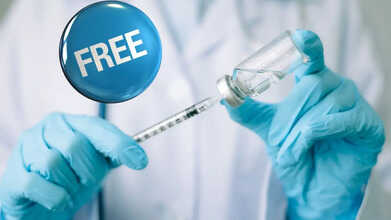- Health Conditions A-Z
- Health & Wellness
- Nutrition
- Fitness
- Health News
- Ayurveda
- Videos
- Medicine A-Z
- Parenting
- Web Stories
Can Drinking Alcohol Increase Your Risk Of Pancreatic Cancer? WHO Study Reveals Alarming Link

A new study led by the World Health Organization (WHO) has cautioned against the further health risks of alcohol. The latest data from WHO's International Agency for Research on Cancer (IARC) indicate that drinking alcohol—particularly beer and spirits—has now been convincingly implicated with a heightened risk of pancreatic cancer, independent of smoking history or sex.
This new research, based on a global cohort of nearly 2.5 million participants on four continents, is one of the largest of its type. It highlights a small but important link between alcohol consumption and pancreatic cancer—a particularly deadly cancer that is usually diagnosed too late to treat successfully.
Also Read: Japan Races To Develop World’s First Artificial Blood, Trials To Begin
Although alcohol is a confirmed carcinogen, its association with pancreatic cancer has long been a grey area, shrouded in controversy due to conflicting evidence and confounding by the role of tobacco smoking. The IARC study provides firmer evidence.
"Drinking alcohol is a recognized carcinogen, but up until now, evidence supporting the association with pancreatic cancer has been labeled as inconclusive," noted study senior author Pietro Ferrari, Head of the Nutrition and Metabolism Branch at WHO-IARC.
Drawing from pooled data from Asian, Australian, European, and North American epidemiological cohorts, the research sets up alcohol as an independent risk factor—a finding of significant significance, particularly for non-smokers who have unwittingly downplayed the effects of moderate to heavy drinking in the past.
Also Read: CDC No Longer Recommends COVID Vaccine For Kids And Pregnant Women - What Do Experts Think?
Does Risk Increases with Alcohol Quantity?
The research revealed a dose-response relationship: the more alcohol consumed, the higher the risk. Each additional 10 grams of alcohol per day—the equivalent of a small glass of wine or half a pint of beer—was associated with a 3% increase in pancreatic cancer risk.
In women, 15 to 30 grams per day (about one to two standard drinks) was associated with a 12% increased risk compared with light drinkers. In men, 30 to 60 grams per day (two to four drinks) was associated with a 15% increase in risk, and those who drank greater than 60 grams per day had a 36% increase in risk.
These numbers are especially worrisome considering that studies even on moderate drinking—popular and socially accepted, by the way—are calculable in damage.
One of the research's most significant revelations is that the alcohol-pancreatic cancer connection holds true even among non-smokers. This is an elimination of a generation-long hypothesis that tobacco was perhaps the major offender in past research.
Also Read: Female Cancer Crisis On An Increase, Climate Change Could Be Responsible
"Examination of our data revealed that the link exists even among non-smokers, and that alcohol in itself is an independent risk factor," Ferrari said.
The message is obvious: even smokers who don't smoke, but drink alcohol daily, are at increased risk of one of the most lethal cancers.
Why Pancreatic Cancer Is So Dangerous?
Pancreatic cancer accounts for about 3% of all cancers in the U.S. but is responsible for 7% of all cancer deaths, according to the American Cancer Society. This disproportionate fatality rate is largely due to its late detection.
The pancreas, a gland tucked behind the stomach, plays a vital role in digestion and blood sugar regulation. Unfortunately, its deep anatomical location often allows tumors to grow silently.
By the time symptoms such as jaundice, weight loss, or abdominal pain become apparent, the disease is usually in its advanced stages, with patients having few options for treatment and a poor prognosis.
Risk Factors of Pancreatic Cancer
Alcohol use is not the only risk factor for pancreatic cancer. Researchers and clinicians have long been aware of several other biological, lifestyle, and environmental risk factors, which include:
Smoking
Smoking also doubles the risk of cancer of the pancreas. Tobacco is one of the most common and preventable risk factors in the world despite campaign efforts on public health.
Chronic Pancreatitis
Chronic pancreatitis, frequently caused by years of heavy alcohol consumption or by gallstones, can develop into a pre-cancerous process. Inflammatory cells produce growth factors and toxins that cause DNA damage, which may eventually induce malignant transformation.
Family History and Genetic Predisposition
Even though the majority of pancreatic cancer patients lack a family history, genetic predisposition is a factor. Gene mutations such as BRCA2 and PALB2 are increasingly being researched for their contribution to pancreatic cancer risk.
Age, Gender, and Ethnicity
Age: The majority of pancreatic cancers are diagnosed between 60 to 80 years of age.
Gender: Men are more likely to be affected compared to women.
Race: Incidence among African Americans is greater than among whites, Asians, or Hispanics.
Diabetes and Diet
Type 2 diabetics are also at a somewhat higher risk. Furthermore, diets high in processed foods and sugary drinks may be linked to cancer risk, although more studies are required for final conclusions.
In spite of the strength of the WHO-IARC study, scientists emphasize the necessity for further studies to investigate other nuances—namely patterns of lifetime alcohol use, binge drinking, and exposure to alcohol in early life.
Recognizing how long-term patterns of behavior affect cancer development could guide more successful public health interventions and early detection.
Pancreatic Cancer Symptoms
Pancreatic cancer signs and symptoms are often vague and non-specific, so early diagnosis can be difficult. Some of the most important ones to be aware of are:
- Upper abdominal pain that could radiate to the back
- Weight loss that is unexplained
- Jaundice (yellowish skin and eyes)
- Floating or pale stools
- Dark-colored urine
- Diabetes that develops suddenly
- Weakness and fatigue
Anyone who has these symptoms on a regular basis should see a healthcare provider right away. Early diagnosis, while uncommon, dramatically enhances treatment success.
Public health institutions would in turn need to reassess alcohol consumption recommendations, particularly those that have earlier defined "moderate drinking" as risk-free.
While alcohol is inextricably tied to much social and cultural activity across the globe, the increasing evidence of its carcinogenicity—now adding pancreatic cancer to the list—requires a more conservative narrative.
The WHO-conducted research brings strong evidence that alcohol is not only a liver-destroying substance; it's also a powerful causative factor in one of the deadliest forms of cancer, even among individuals who have never smoked.
CDC Reports Six Deaths Tied To Listeria Outbreak In Packaged Meal Products

Credits: CANVA
A widespread listeria outbreak traced to contaminated ready-to-eat meals has resulted in at least six deaths and 27 hospitalizations across 18 states, according to the Centers for Disease Control and Prevention (CDC).
The Food and Drug Administration (FDA) has advised consumers to inspect their freezers for potentially affected items tied to the ongoing infections.
Nate’s Fine Foods, the company behind the products connected to the outbreak, issued a statement on September 29 confirming that listeria was found in some of its food products.
Listeria Outbreak Expands Across States, Linked to Ready-to-Eat Pasta Products
The number of deaths has increased in the ongoing listeria outbreak connected to ready-to-eat pasta dishes sold at major retailers including Walmart, Kroger, and Trader Joe’s.
According to the Food and Drug Administration (FDA), seven new cases of listeria infection have been confirmed in three additional states since the previous update on September 25. The outbreak has now affected 27 people across 18 states and caused six deaths as of October 30.
Of those infected, 25 required hospitalization, and one case involved a pregnancy-related loss, the FDA noted. The FDA, along with the U.S. Department of Agriculture (USDA) and the Centers for Disease Control and Prevention (CDC), continues to investigate the nationwide outbreak.
The investigation, which began in June, has traced the outbreak to contaminated precooked pasta produced by Nate’s Fine Foods, Inc. The tainted pasta was used in a variety of ready-to-eat items, including pasta salads, frozen meals, and deli products distributed through several major grocery chains.
What Is Listeria?
Listeria is a harmful bacterium that causes listeriosis, a serious infection spread through contaminated food. It is commonly found in soil, water, and various ready-to-eat items such as deli meats, soft cheeses, and prepackaged meals like the recently recalled pasta sold at Walmart.
Unlike most bacteria, Listeria can survive and multiply in cold environments, including refrigerators, which is why safe food storage and thorough cooking are essential, according to the Centers for Disease Control and Prevention (CDC).
Who Is Most at Risk from Listeria?
Although anyone can become infected, certain people face a greater risk of complications. These include pregnant women, newborns, older adults, and individuals with weakened immune systems. In pregnant women, the infection can lead to miscarriage, stillbirth, or severe illness in newborns.
Symptoms of listeriosis usually appear within two weeks of eating contaminated food. The illness often starts with digestive discomfort, including nausea or diarrhea, and can progress to more severe signs such as fever, muscle aches, headaches, stiff neck, confusion, and loss of balance.
Full List of Recalled Products Linked to Listeria Outbreak
According to The Associated Press, the following ready-to-eat meals have been recalled due to potential Listeria contamination:
- Sprouts Smoked Mozzarella Pasta Salad – sold from deli or Grab & Go section; best-by dates Oct. 10–29
- Giant Eagle Smoked Mozzarella Pasta Salad – expiration dates Sept. 30–Oct. 7
- Kroger Deli Bowtie and Penne Pasta Salads – sold Aug. 29–Oct. 2
- Scott & Jon’s Shrimp Scampi with Linguini Bowls (9.6 oz) – best if used by Mar. 12, 13, 17, and 21, 2027
- Trader Joe’s Cajun Style Blackened Chicken Breast Fettuccine Alfredo (16 oz) – best if used by Sept. 20, 24, 27, 28; Oct. 1, 3, 5, 8, and 10
- Albertsons Deli Pasta Salads – sell through dates Sept. 8–Oct. 4
- Marketside Linguine with Beef Meatballs & Marinara Sauce (12 oz) – best-by Sept. 22, 24, 25; Sept. 29–Oct. 1
- Marketside Grilled Chicken Alfredo with Fettuccine (12.3 oz) – best-by June 26 or earlier; (32.8 oz) – best-by June 27 or earlier
- Home Chef Chicken Fettuccine Alfredo (12.5 oz) – best-by June 19 or earlier
What Health Conditions Has President Donald Trump Been Diagnosed With?

Credits: Canva
Donald Trump Health: Trump visited Walter Reed National Military Medical Center on October 10 for what he described as his “semi-annual physical.” He had already undergone a routine check-up in April. Speaking to reporters aboard Air Force One on his way to Japan, Trump confirmed that he received an MRI during his appointment.
“I did, I got an MRI—it was perfect,” Trump said, adding that reporters would need to ask his doctors for the reason behind it. “I think they gave you very conclusive reports. Nobody has ever given reports like I did. And if I didn’t think it would be good, I wouldn’t run. The doctor said they were some of the best results for someone my age.”
What Is An MRI?
MRI stands for magnetic resonance imaging. It produces detailed scans of internal soft tissues and is commonly used for examining organs and detecting abnormalities.
When Did Trump Visit Walter Reed?
Trump went to Walter Reed on April 11 for a physical. According to White House physician U.S. Navy Captain Sean Barbabella, Trump was in excellent health, and his cholesterol levels were well-managed.He returned to Walter Reed on October 10 for “advanced imaging, laboratory tests, and preventive evaluations.” During the same visit, Trump also received his flu and COVID-19 booster vaccinations. Barbabella later stated that the former president remains in “excellent overall health.”
What Health Condition Has Trump Been Diagnosed With?
Earlier this year, the White House disclosed that Trump has chronic venous insufficiency (CVI), a common vascular disorder in which leg veins struggle to return blood to the heart properly. This condition can cause swelling and discomfort in the legs.
On October 10, Trump made another trip to Walter Reed National Military Medical Center. His spokesperson, Karoline Leavitt, described it as a “routine annual check-up,” even though it was his second visit to the facility in just six months. Dr. Sean Barbabella, the White House physician, did not provide details about the imaging or preventive evaluations carried out during the appointment. However, he stated that Trump’s lab results were “exceptional” and that his cardiac health appeared to be roughly 14 years younger than his actual age.
On October 27, Trump mentioned that he had undergone an undisclosed MRI scan during a previous visit to Walter Reed. Though he said the test produced “some of the best reports for the age” and “some of the best reports they’ve ever seen,” the lack of details surrounding the procedure has fueled speculation about his health.
Trump has also previously spoken about taking the Montreal Cognitive Assessment (MoCA), a test used to detect cognitive decline, but has repeatedly described it as a “very difficult IQ test.” It is not known whether another MoCA test was conducted during his October visit or if Trump was referring to the tests he took in April 2025 or January 2018.
Who Can Get The Flu Shot For Free This Season? Check If You Are Eligible As Cases Rise

Credits: CANVA
A wide range of people in the UK may be eligible for a free flu vaccine this season after the NHS confirmed that infections are increasing “earlier than usual.” Each year, the NHS provides flu vaccinations throughout autumn and early winter, as this is when flu activity tends to peak. Although influenza is typically mild for most people and symptoms clear up within a few weeks, some individuals face a much higher risk of serious complications and therefore need extra protection.
To ensure those at greatest risk are shielded from severe illness, the flu jab is offered free of charge to certain groups.
According to NHS England on X (formerly Twitter): “Flu cases have arrived earlier than usual and are already three times higher than this point last year, with infections climbing fastest among children. So far, NHS teams have administered 12.2 million flu vaccines to help safeguard the most vulnerable.”
How the Flu Jab Protects You?
The flu vaccine trains your immune system to recognise and fight the influenza virus without needing to be infected first. It contains a small, inactive portion of the flu virus, which triggers your body’s natural defences to produce antibodies.
After receiving the jab, it takes around ten days for protection to fully develop. Importantly, the vaccine cannot cause the flu, as the virus it contains is inactive. Most people only need one dose each year to stay protected through the season.
Who Can Get the Flu Jab for Free?
As per current NHS guidelines, six main groups of people can receive the flu jab at no cost. You qualify for a free vaccination if you are at higher risk or live with someone who may be.
Those eligible include:
- Adults aged 65 or older, or anyone turning 65 by March 31, 2026
- People living with someone whose immune system is compromised (for example, those undergoing chemotherapy)
- Main carers for older or disabled individuals, or anyone receiving carer’s allowance
- Individuals with certain long-term medical conditions
- Residents of care homes
- Pregnant women
How to Access Your Free Flu Vaccine?
If you qualify, you can receive the free vaccine in several convenient ways. You may book an appointment through your GP practice, or if you are aged 18 or over, you can arrange one online or through the NHS App at a participating pharmacy.
Many pharmacies also allow eligible individuals to walk in for the jab without a prior appointment, making it easier for those who need protection to get vaccinated quickly and safely.
However, not every pharmacy is part of the free flu vaccination programme. You can check which nearby pharmacies offer the service through the NHS website’s locator tool. The site also provides complete details about the flu vaccine, including information on its ingredients and how it works.
© 2024 Bennett, Coleman & Company Limited

